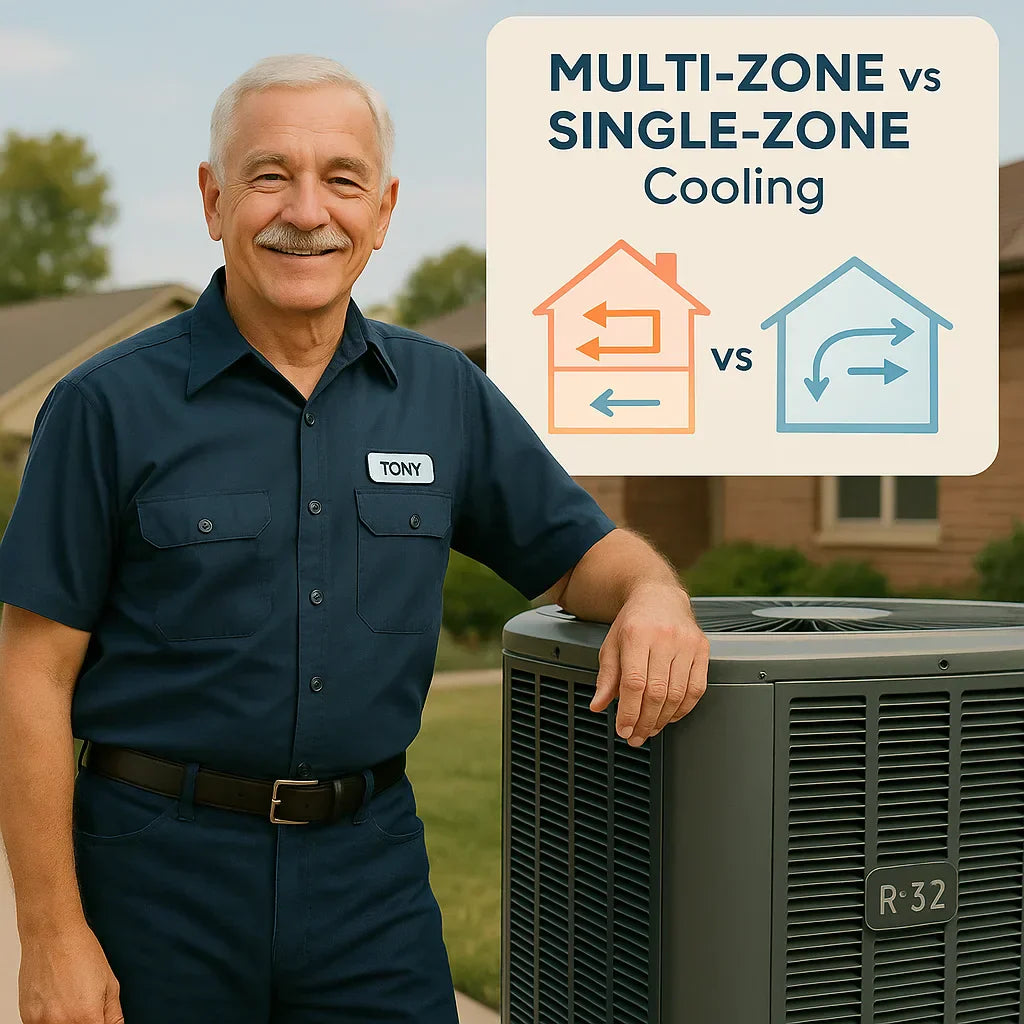When planning to install a 4-ton R-32 AC system, homeowners often ask: Should I go with single-zone cooling or invest in a multi-zone setup? Understanding the differences can help you maximize comfort, efficiency, and budget alignment in your home.
Tony breaks it down simply so you can decide what makes sense for your space and lifestyle.
🏠 What Is Single-Zone Cooling?
A single-zone system cools your entire home using one thermostat and delivers air through ductwork evenly across all areas.
✅ Best for:
-
Open-concept layouts
-
Smaller homes (under 2,500 sq. ft.)
-
Homes with consistent usage patterns across rooms
✅ Pros:
-
Lower upfront cost
-
Simpler to install and maintain
-
Easy to operate
✅ Cons:
-
Less control over room-to-room temperatures
-
Can cool unused areas unnecessarily
Learn the basics on Energy Star’s AC guide.
🪐 What Is Multi-Zone Cooling?
A multi-zone system allows you to divide your home into zones (bedrooms, living areas, etc.) with individual thermostats or dampers controlling airflow.
✅ Best for:
-
Two-story homes
-
Large homes with varying occupancy in different rooms
-
Homes with sunrooms, additions, or finished basements
✅ Pros:
-
Customized comfort by room or zone
-
Increased energy efficiency by avoiding cooling unused areas
-
Improved humidity control
✅ Cons:
-
Higher upfront installation cost
-
More complex system requiring precise design
See zoning system basics from Trane.
⚡ Can a 4-Ton R-32 AC System Be Used for Zoning?
Yes, many 4-ton R-32 systems can be integrated with zoning dampers and smart thermostats to create a multi-zone system.
Zoning typically uses:
-
Motorized dampers in the ductwork
-
Zone control boards to manage airflow
-
Multiple thermostats for individual areas
Important: Zoning with a single central system is different from using multiple ductless mini-split systems, which are individual units per zone.
Learn how zoning integrates with central AC systems on HVAC.com.
📈 Efficiency and Energy Savings
Single-Zone:
-
Simpler system with fewer moving parts
-
Can waste energy cooling empty rooms
Multi-Zone:
-
Saves energy by reducing airflow to unused zones
-
Allows for lower energy consumption during partial occupancy
The Department of Energy notes that zoning can save homeowners up to 30% on cooling costs depending on usage and layout
💧 Comfort and Humidity Control
Zoning with a 4-ton system can:
✅ Eliminate hot and cold spots
✅ Allow sleeping areas to stay cooler at night while other zones remain higher
✅ Improve humidity control by reducing system short-cycling
💰 Cost Considerations
Single-Zone:
-
Lower equipment and installation costs
-
Fewer components to maintain or repair
Multi-Zone:
-
Adds $1,500–$4,500 to installation costs (depending on the number of zones and dampers)
-
May require ductwork modifications
-
Provides energy savings over time to offset upfront costs
🔧 Maintenance and Complexity
Single-Zone:
✅ Easier to maintain
✅ Less to troubleshoot
Multi-Zone:
✅ Requires periodic checks of dampers and control boards
✅ Adds complexity but provides precise comfort control
🏡 Home Layout Considerations
✅ Open layouts: Single-zone systems often work well. ✅ Multi-level homes: Zoning prevents temperature stratification. ✅ Sunrooms or additions: Zones prevent overcooling the main living areas. ✅ Large homes with varied occupancy: Zoning saves money and improves comfort.
Use HVAC Quick’s duct sizing calculator to plan for airflow needs in zoning.
🤝 Tony’s Practical Advice
“Zoning can be worth every penny if you have a bigger home, live in a hot climate, or have rooms you don’t use all day. But if you’re in a smaller, open floor plan, a single-zone 4-ton system will handle your comfort just fine.”
✅ Always confirm system sizing with a Manual J load calculation before adding zoning.
✅ Use programmable thermostats to maximize zoning benefits.
✅ Get professional installation to avoid airflow and pressure issues in a multi-zone setup.
🚀 Next Steps
1️⃣ Evaluate your home’s size, layout, and lifestyle needs.
2️⃣ Decide if you need room-by-room control or if single-zone is sufficient.
3️⃣ Request quotes for both options from licensed HVAC professionals.
4️⃣ Check if your system qualifies for rebates when upgrading to an R-32 system (DSIRE database).
5️⃣ Explore compatible 4-ton R-32 AC systems at The Furnace Outlet to align your comfort and efficiency goals.
Choosing the right configuration ensures your 4-ton R-32 AC system delivers comfort and savings that match your lifestyle while preparing your home for the future.
In the next topic we will know more about: How to Maximize Efficiency with Your 4-Ton R-32 AC and Gas Furnace Combo







